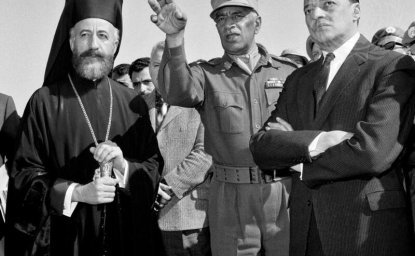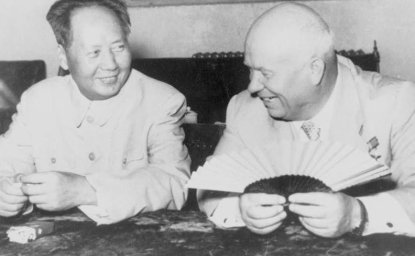WASHINGTON, D.C.-Previously secret KGB materials on the Soviet war in Afghanistan reveal the determined efforts of a great power trying desperately to keep on top of events in a client state-and failing miserably to do so. The materials were released today by Cold War International History Project (CWIHP) at the Woodrow Wilson International Center for Scholars, the leading clearinghouse and research project on the former Communist world archives.
The materials, provided to CWIHP by defected KGB archivist Vasiliy Mitrokhin, present the first behind-the scene account at the three communist coups in Afghanistan in April 1978 and in September and December 1979. They also provide the first-ever inside account of the 1979 kidnapping and murder of the last US ambassador in Kabul, Adolph Dubs; chilling reports on the violent guerrilla deception campaigns, assassinations, sabotage and bribery carried out by the KGB in Afghanistan between 1978 and 1983; as well as new information on clandestine US-Soviet political contacts on Afghanistan in the 1980 presidential election campaign. The document also reveals KGB and Afghan intelligence cooperation with Murtaza Bhutto, the brother of later Pakistan prime minister Benazir Bhutto; as well as links with Murtaza Bhutto, a leftist terrorist involved in organizing and supervising the hijacking of a Pakistani civilian airliner in 1981. The 178-page paper proves that the KGB was deeply involved in Afghanistan even before the Communist take-over in 1978 and the Soviet invasion in 1979. The number of active agents in the country ran into the hundreds and served a role not only in Afghanistan but also in neighboring countries such as Pakistan and Iran. The government of Prince Muhammad Daud (1973-1978) worked closely with the Soviets, and several of Daud's ministers had contacts with the KGB. Mitrokhin also shows that the Soviet Union was not involved with the Afghan Communists' overthrow of Daud's government in April 1978, although the KGB had received advance warning of the plot against Daud. The KGB spent enormous sums to rapidly build up indigenous Afghan communist intelligence services, of which the main one, the KHAD, became feared and hated for its use of torture and assassination. KGB-trained agents, the records make clear, substantially penetrated CIA-backed mujaheddin groups, their training camps, and their headquarters.
More importantly, the KGB files present, according to Christian Ostermann, the director of the Cold War International History Project, "the inside story of the growing split between Afghan Communist Party leaders Babrak Karmal, Mohammad Taraki and Hafizullah Amin-and the rather frantic Soviet efforts to keep it under control"-advising the Afghans, for example, after Taraki's guards had machine gunned Amin's, that 'in the present circumstances it was particularly important to be restrained and controlled.' The Mitrokhin materials reflect the rivalry among the main Soviet agencies operating in Afghanistan-the embassy, the military, the KGB, and the party advisers, often at cross-purposes. Examples include the KGB surveillance of the messenger whom General Zaplatin, the Soviet chief political adviser to the Afghan army, sent to Moscow in December 1979 in a desperate attempt at preventing a Soviet invasion; and the failed attempt at removing Amin from power in September 1979, in which Soviet ambassador Puzanov became a hapless diplomatic victim of a KGB-hatched plot. Among the many new details on KGB operations in Afghanistan and other countries are the accounts of the September 1979 Operation "Raduga," the KGB's high-risk scheme to usher three Afghan cabinet ministers out of the country, and "Operation Agat," the storming of the presidential palace and the killing of Amin in December 1979, at the onset of the Soviet invasion.
What is most striking about Mitrokhin's materials is the pervasive sense it gives of the distrust that the KGB fomented and spread among Afghan and Soviets alike. While it is clear that Moscow's interest in the critical year 1979 lay in finding ways for the two main Communist Party factions to cooperate against their increasingly efficient Islamist enemies, the KGB's operations achieved exactly the opposite. By concocting rumors and slander, the KGB contributed significantly to the destruction of the Afghan Communist Party and to the dysfunctionality of Soviet policies. It is therefore fitting that it was the local KGB bosses who-sensing their chief Yuri Andropov's willingness to use force to remove Amin from power-dredged up old, faction- driven accusations of Amin being an American agent that in the last resort convinced many in Moscow, who should have known better, that it was necessary to invade.
The KGB ran scores of secret "false flag" military operations inside Afghanistan during the 1980s. In these, Soviet-trained Afghan guerrilla units posed as CIA-supported, anti-Soviet mujaheddin rebels to create confusion and flush out genuine rebels for counterattacking. By January 1983, there were, according to Mitrokhin, 86 armed, KGB-trained "false bands," as they were called, operating throughout Afghanistan. These disclosures also throw new light on the chronic mujaheddin infighting during the 1980s. A perhaps significant number of the clashes among mujaheddin groups during the 1980s, which set the stage for the catastrophic civil war in the 1990s, apparently were carried out deliberately by paid KGB agents. A KGB operative but increasingly disaffected following the bloody suppression of the Prague Spring in 1968 and the dissident movement, Vasiliy Mitrokhin decided to compile his own account of the KGB's foreign operations when he was put in charge in 1972 of the transfer of the foreign operations archives from the KGB's headquarters at Lubyanka in Moscow to Yasenevo southwest of the capital. Working in complete secrecy for over ten years, Mitrokhin first took notes in longhand while working in the archives and later, once safely in his dacha, sorted and transcribed them. They are now being made available at no charge by the CWIHP at http://cwihp.si.edu.

Cold War International History Project
The Cold War International History Project supports the full and prompt release of historical materials by governments on all sides of the Cold War. Read more




